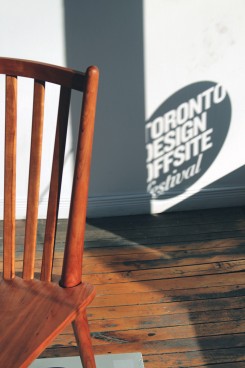Not nearly as well advertised or well known as Nuit Blanche, the Toronto Design Offsite Festival (TDOF) is a chance to experience art without the crowds, and celebrate the beauty that exists in the mundane objects present throughout our everyday life.
The one-week event transforms the city into a platform for celebrating the uniqueness in local art initiatives. Divided into three components, the festival offers events, exhibits, and window installations.
All across the city, exhibits are built upon objects and the interplay of feeling and belonging. One exhibit, entitled “Hollace Cluny Introduces the Bec Brittain Collection” showcases lighting based on innovative and forward thinking technology. The lighting installations in the exhibit expose spectators to traditional lighting in new and creative ways.
Similarly, “1/16”, an exhibit housed at the Craft Ontario Gallery, presents 16 individually crafted pieces by 16 graduate students. At first glance, the white walls and soft natural woods of the gallery don’t seem to make for an impressive setting. Walking farther into the gallery, however, brings the realization that it is full of distinct interpretations of traditional chairs (16, to be exact). Standouts include the “Team Slayer Gaming Chair,”, “Loveseat,” the “Walnut Barstool,” with each chair seeming to represent a different aspect of our lives, leaving you with the realization that everyday objects can have artistic merit.
“Urban Fabric: Portraits of a City” at the Textile Museum examines both the intimacy and the isolation that can come from living in a city like Toronto. Through the use of photographs, sculptures, videos, and fabrics, the exhibit tells the story of both natural and industrial environments. Artist Sheila Ayearst paints three representations of concrete in Toronto streets: “Dundas West Concrete,” “Lisgar Concrete,” and “Beaconsfield Concrete,” each represented with their own unique textures.
Her paintings evoke a sense of nostalgia for the urban setting in which we live. A painting of weathered concrete is able to create feelings of empowerment, unity, and togetherness.
In another portion of the exhibit, Jessica Craig photographs 12 “hidden” spaces that encompass Toronto’s natural geography. The contrast between her work and Ayearst leads us to wonder about the functionality of art: what is more important — the sense of identity to be found in the concrete paintings, or the permanence of our city’s natural geography?
The TDOF manages to revitalize one of the city’s neglected art scenes. It provides the artistic community with an opportunity to experience unique portrayals of the city through subtle and diverse installations. The festival succeeded in incorporating art into the everyday, challenging viewers’ perspectives on the structures that make up their daily routines.



